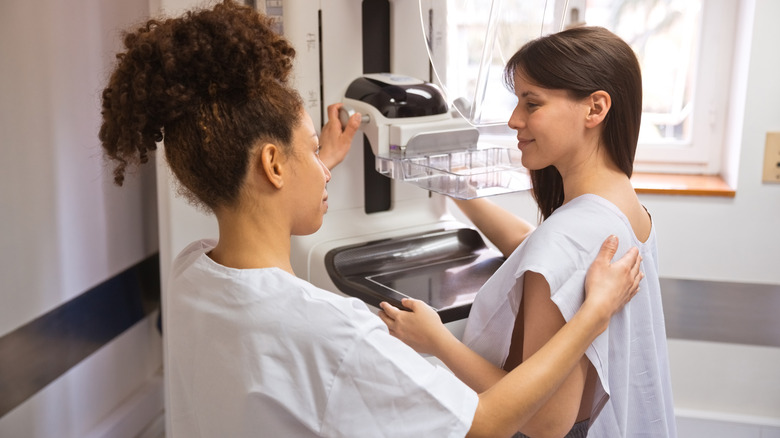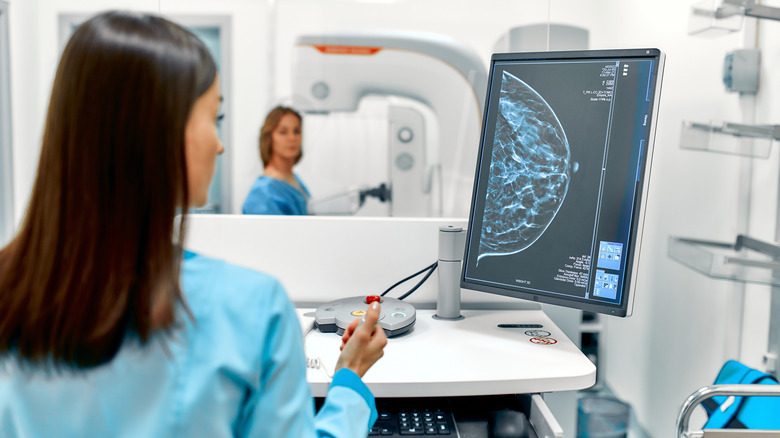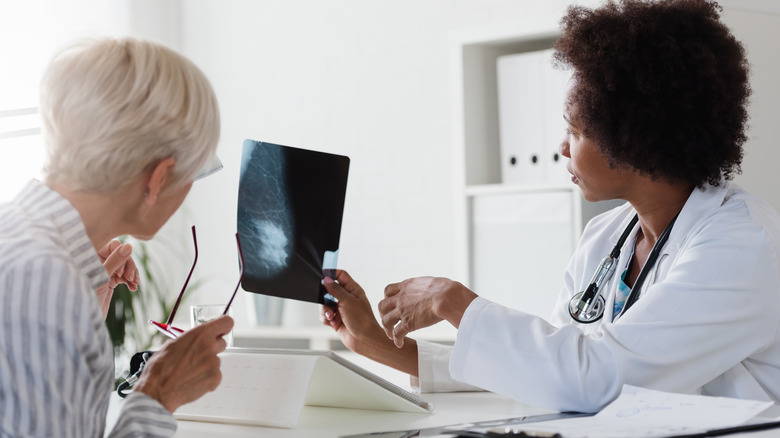What The New Age Recommendation For Mammograms Means For You
Getting a mammogram can be an uncomfortable experience since your breasts get essentially sandwiched between two plates to get the X-ray images. You can potentially help minimize the pain by not scheduling your mammogram in the week before your period as that's when breasts can be more tender and sensitive. Another way to help make the experience a bit easier is to wear comfy clothes to your mammogram.
Any pain that you feel should be over pretty quickly as it's not a long procedure, so don't let the potential for pain stop you from getting a mammogram. It can be a life-saving procedure as it can help detect breast cancer early, with the Centers for Disease Control and Prevention noting that mammograms can catch breast cancer up to three years before you can feel any change in your breast tissue.
This is what you can expect from a breast cancer screening, but when should you start getting mammograms? On May 9, 2023, the United States Preventive Services Task Force (USPSTF) released a draft recommendation updating when they feel people should begin getting mammograms. Previously, they'd recommended age 50 for anyone at average risk for breast cancer, and only for younger women if they had risk factors. However, they've updated that to age 40 for everyone. Here's why they changed it and what you need to know.
The recommended age for a mammogram for all women starts at 40
The USPSTF is an independent panel of experts that issues recommendations related to keeping people healthy and preventing disease. The task force explained that the breast cancer screening update was necessary on their website, saying, "New and more inclusive science about breast cancer in people younger than 50 has enabled us to expand our prior recommendation and encourage all women to get screened in their 40s." They also commented on the issue of racial disparity and breast cancer — mortality rates for Black women with breast cancer are higher when compared to white women, according to scientific research. The USPSTF is calling for more research into what can be done to combat that disparity.
It's of real concern to the task force. "We don't really know why there has been an increase in breast cancer among women in their 40s," Dr. Carol Mangione, former chair of the USPSTF, told The New York Times. "But when more people in a certain age group are getting a condition, then screening of that group is going to be more impactful."
The previous recommendation for breast cancer screenings by the USPSTF was made in 2016, which said screenings for women in their 40s resulted in a higher amount "of false-positive results and unnecessary biopsies" compared to women ages 50 to 74. The new draft recommendation is open for public comment until June 5.
The age change is just one recent mammogram update
If mammograms can help catch breast cancer, it might seem like all people with breasts should get them frequently. However, there are potential reasons to not get overly frequent breast cancer screenings, which was also considered by the USPSTF. For example, a 2017 study published in the Annals of Internal Medicine showed potential for overdiagnosis of breast cancer, which could result in people getting aggressive cancer treatment that they didn't actually need.
Another recent update to mammograms is about breast density. The U.S. Food and Drug Administration issued new amendments to the Mammography Quality Standards Act (MQSA) in March 2023, that include requiring doctor's offices to tell people if they have dense breasts, which applies to about half of the country's women age 40 and up. Dense breasts can make it harder to see cancer on a mammogram and is also a risk factor for breast cancer. CDC explains breast density as the "amount of fibrous and glandular tissue in a woman's breasts compared with the amount of fatty tissue."
The USPSTF isn't the only organization issuing mammogram recommendations, and when to get a mammogram can differ on who you ask. For example, the American Cancer Society recommends women ages 45 to 54 get a mammogram every year, with optional mammograms starting at 40 depending on your family history and other risk factors. Always check with your doctor about their recommendations for you and your health needs.


